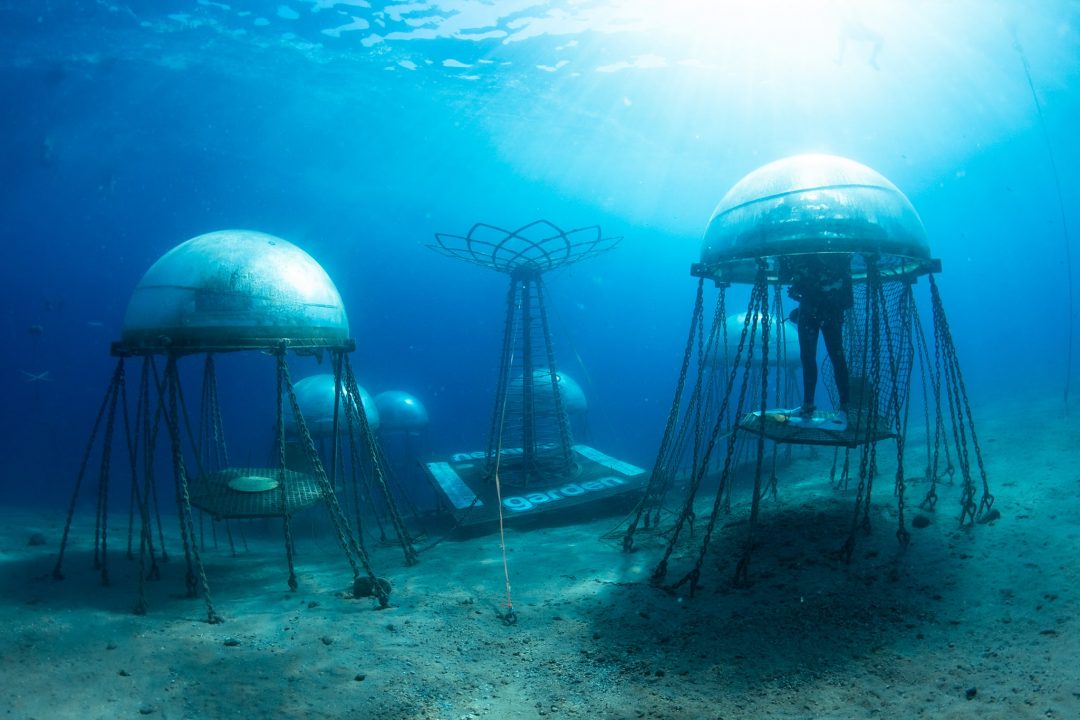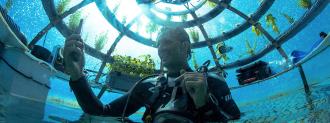In 2013, Italian scuba diver and gardener Sergio Gamberini decided to see if he could grow basil plants in a plastic balloon underwater. The experiment was a success — so he decided to dive deeper into the world of underwater agriculture.
Today, Gamberini is the founder of Nemo’s Garden, a startup using “biospheres” off the coast of Italy to grow a variety of plants, introducing the world to a new type of agriculture.
The underwater garden: Nemo’s Garden’s six “biospheres” are air-filled plastic domes about two meters wide. Each is anchored to the seabed by chains and screws so that it sits between 15 and 36 feet below sea level.
Sunlight warms the air in the biospheres, causing the saltwater below to evaporate and condense as freshwater on the domes’ plastic interiors. That water then drips onto the plants in the underwater garden, most of which are grown hydroponically.

The biospheres are equipped with cameras and sensors that allow Nemo’s Garden researchers to monitor CO2 levels, humidity, temperature, and more from a control tower on the shoreline. There’s also an intercom to communicate with divers in the domes.
Solar panels on the roof of the control tower power the fans that create airflow inside the biospheres, and because the temperature inside and outside the domes is consistent, there’s no need to expend energy on the heating or cooling systems needed for traditional greenhouses.
The underwater garden doesn’t require pesticides since bugs can’t reach the plants, and though more research is needed, Nemo’s Garden notes on its website that the higher pressure conditions underwater appear to help plants grow more quickly.

Looking ahead: In the years since Gamberni first got the idea to create Nemo’s Garden, the startup has tried growing more than 50 types of plants underwater, painstakingly tweaking the biospheres along the way to create the ideal growing conditions.
“We’ve faced multiple challenges in the development of biospheres,” said Project Manager Gabriele Cucchia. “First and foremost, there’s no book — there’s nobody who has done something like that.”
“Every time we want to implement any kind of technology, you need to carefully evaluate all the aspects,” he added. “Then you need to wait for the perfect weather conditions and then you need to dive. So everything we want to bring underwater takes a long time.”
Nemo’s Garden is now ready to transition from the research phase of development to optimizing its biospheres for industrialization, with the goal of deploying the structures off coastlines around the world.
To make the leap, the startup is now taking advantage of “digital twin” technology developed by the industrial giant Siemens to precisely simulate every aspect of its underwater garden.
“[T]here are so many complex laws of physics that interact with our installations that it’s very hard to just imagine these,” said Luca Gamberini, Sergio’s son and co-founder of Nemo’s Garden. “In simulation, we can foresee them, and we can take them all into account at the same time.”
“Until now, we have monitored the growth and health of our plants in a very traditional way,” he continued. “Machine learning and AI will boost that incredibly.”

The bottom line: Even with all the optimization potential offered by technology, Sergio Gamberini admits it’s hard to imagine the produce grown in his startup’s biospheres ever competing financially with traditionally grown crops.
Still, he hopes the system’s sustainability will be enough to draw customers.
“The price for our basil plants will never be comparable to what you pay in a supermarket,” he told Modern Farmer. “That being said, they come with a much reduced environmental footprint.”
We’d love to hear from you! If you have a comment about this article or if you have a tip for a future Freethink story, please email us at [email protected].






